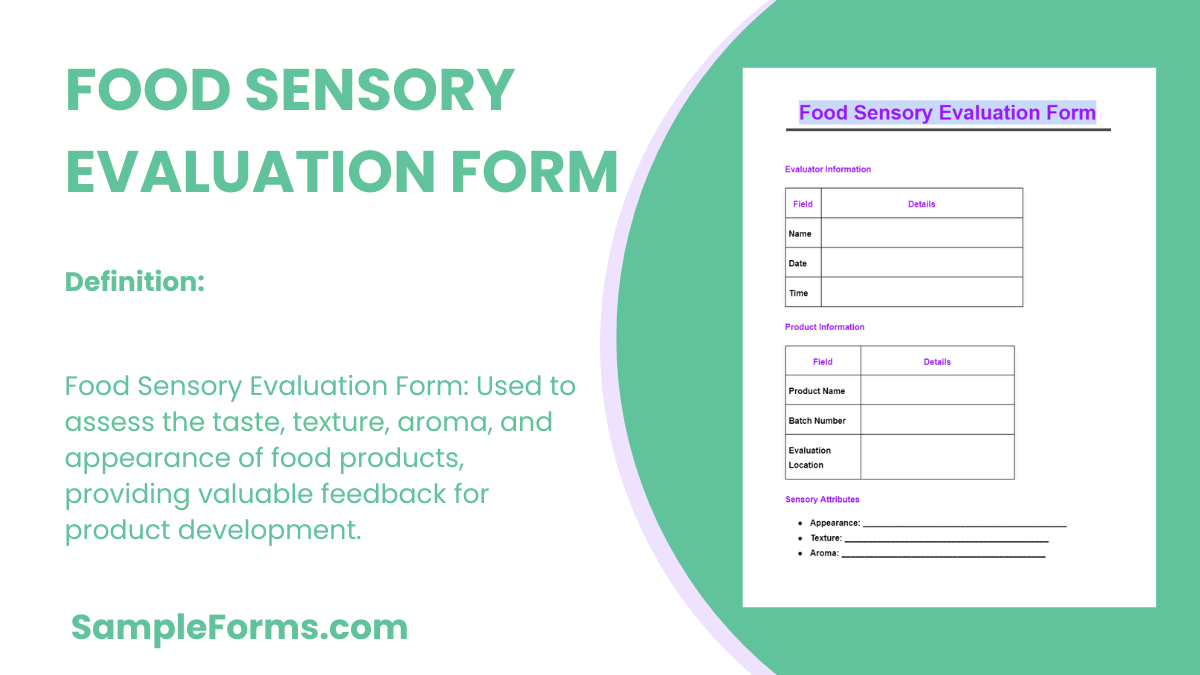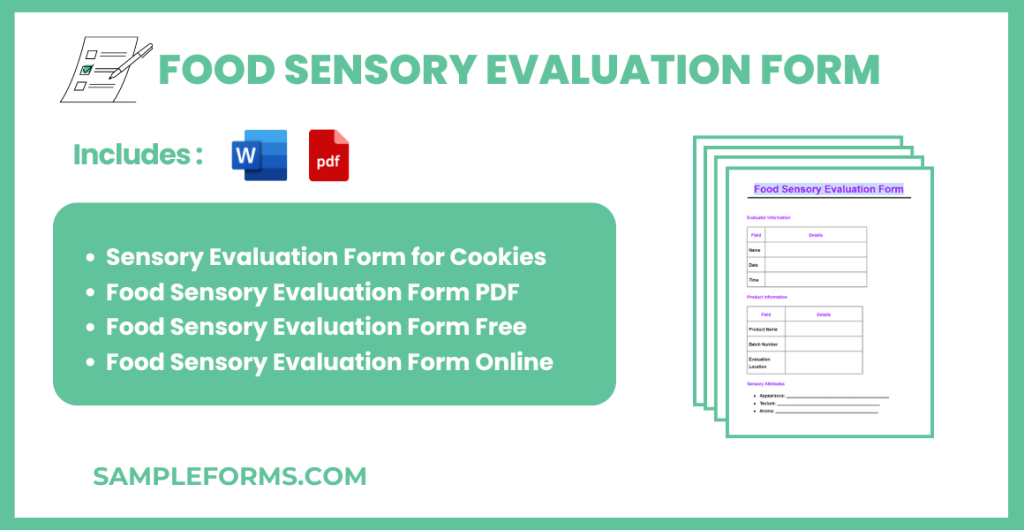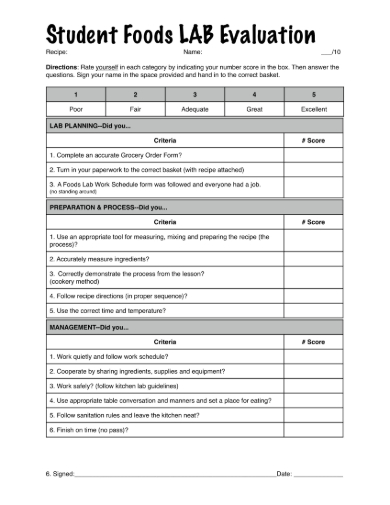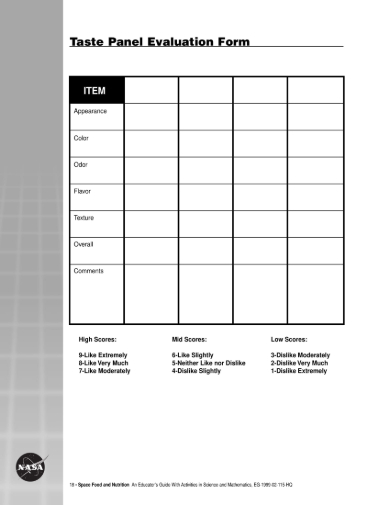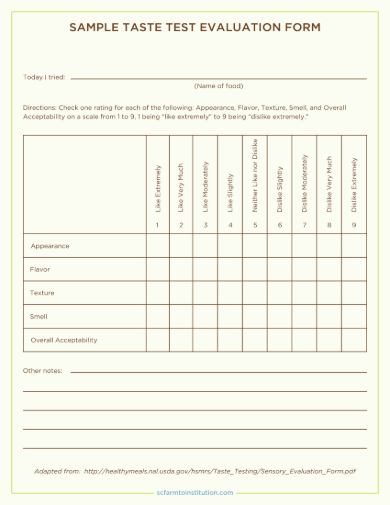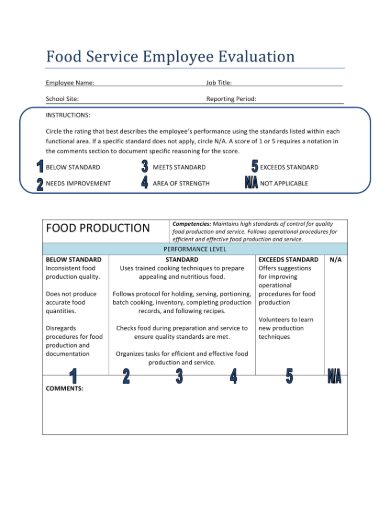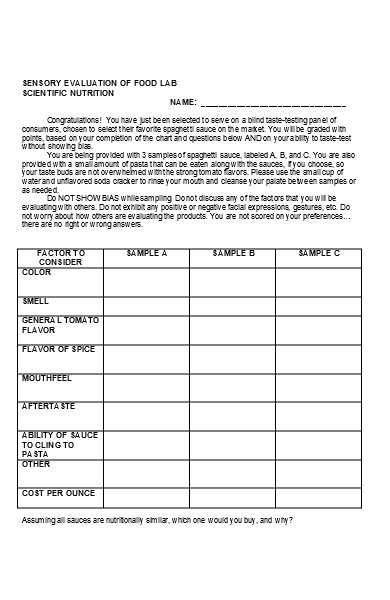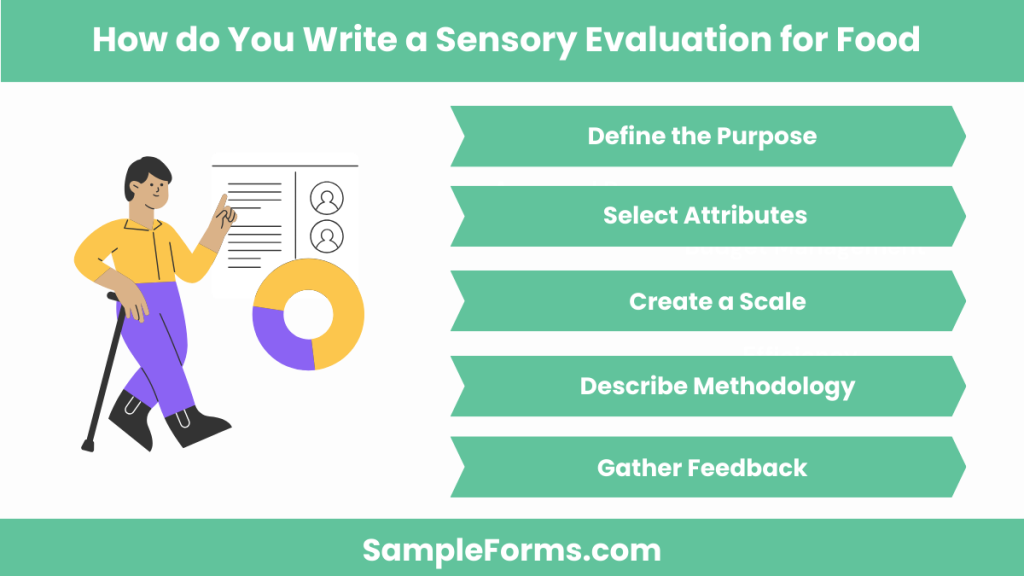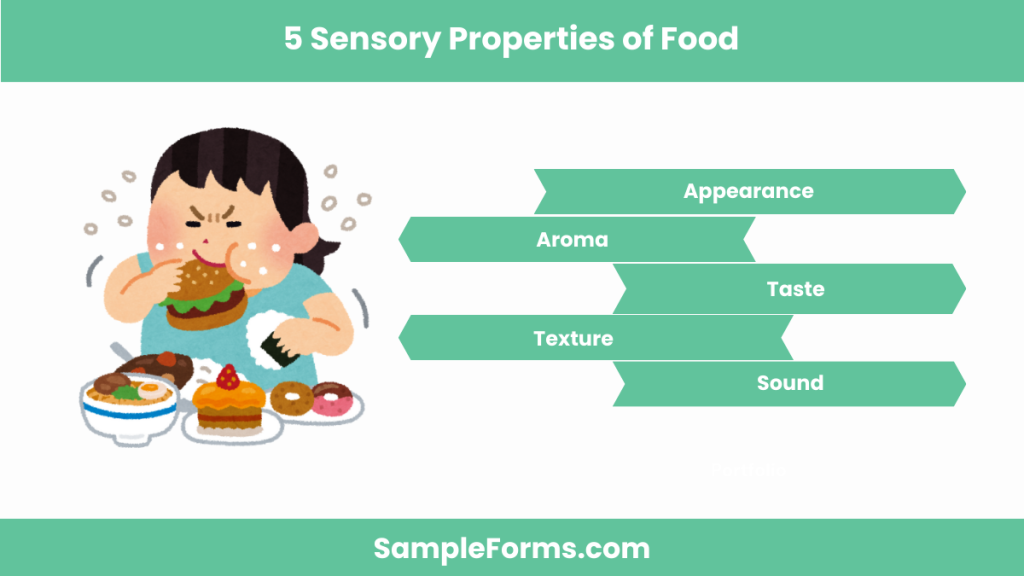A Food Sensory Evaluation Form is essential for assessing the quality and acceptability of food products. This comprehensive guide provides step-by-step instructions and examples for creating effective Evaluation Form. Whether you’re a food scientist, quality control manager, or a culinary professional, understanding how to design a Sensory Evaluation Form for sensory evaluation is crucial. Learn how to measure attributes such as taste, texture, aroma, and appearance to ensure your food products meet consumer expectations. Our guide covers everything from basic concepts to advanced techniques, helping you develop forms that provide valuable insights and drive continuous improvement.
Download Food Sensory Evaluation Form Bundle
What is Food Sensory Evaluation Form?
A Food Sensory Evaluation Form is a structured document used to assess the sensory attributes of food products. It captures data on various parameters such as taste, texture, aroma, and appearance. This form helps in identifying strengths and weaknesses of food items, ensuring quality control and product development. By using an Evaluation Form, companies can systematically gather feedback to improve their offerings, similar to how an HR Evaluation Form is used for performance
Food Sensory Evaluation Format
Food Sensory Evaluation
-
Product Information
- Product Name
- Batch Number
- Date of Evaluation
-
Evaluator Details
- Evaluator Name
- Position
- Date of Evaluation
-
Sensory Attributes
- Appearance
- Color
- Consistency
- Aroma
- Flavor
- Texture
- Overall Acceptability
- Appearance
-
Comments and Suggestions
- Strengths
- Areas for Improvement
-
Rating Scale
- 1 (Poor) to 5 (Excellent)
Sensory Evaluation Form for Cookies
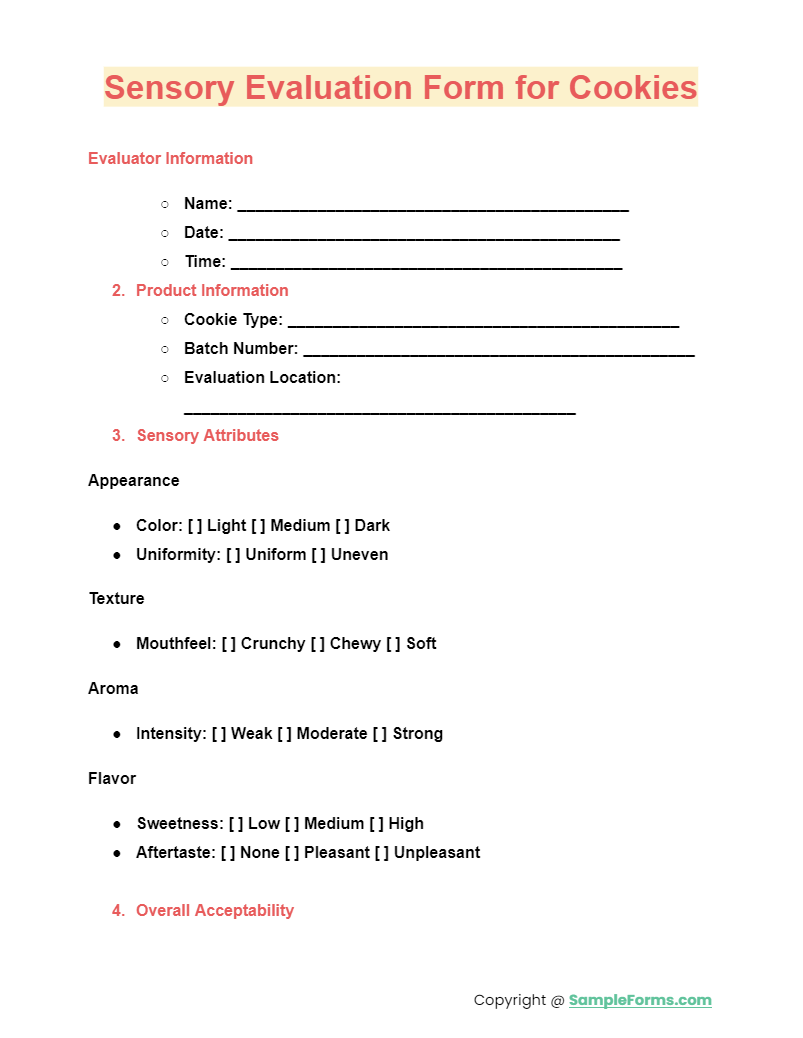
A Sensory Evaluation Form for Cookies is tailored to assess attributes specific to cookies, such as crispiness, sweetness, and flavor balance. This form is designed to provide detailed feedback, similar to a Food Order Form.
Food Sensory Evaluation Form PDF
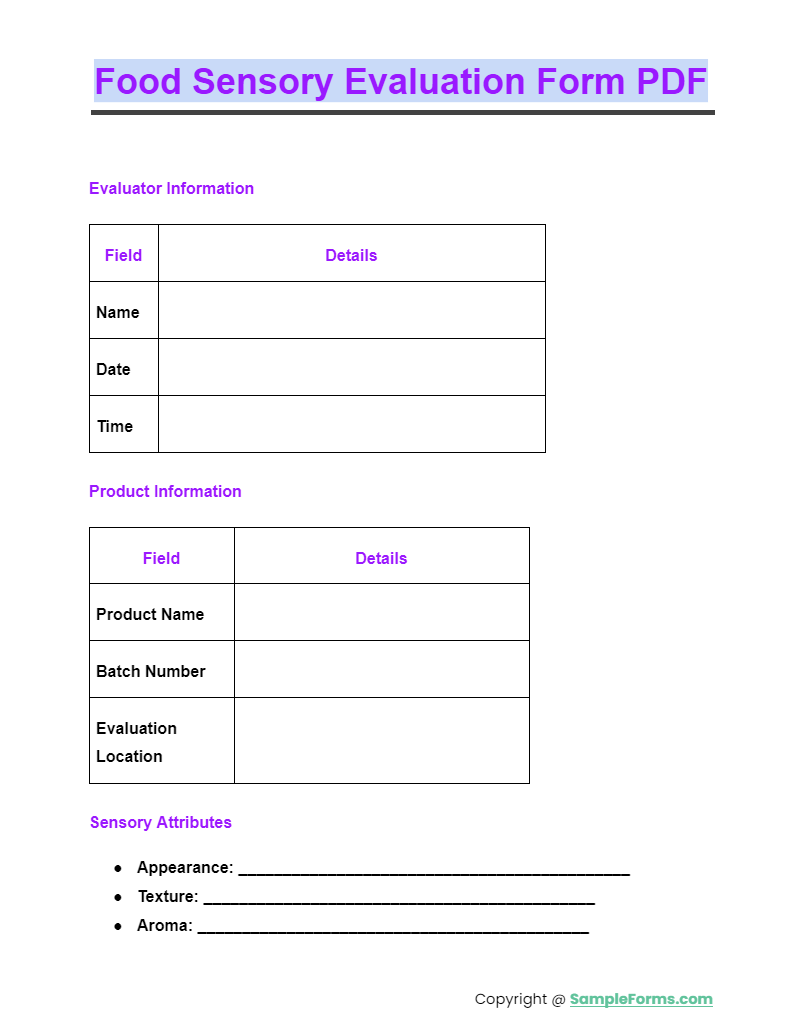
A Food Sensory Evaluation Form PDF offers a convenient and professional format for evaluating food products. This downloadable and fillable form ensures comprehensive data collection, akin to a Food Evaluation Form.
Food Sensory Evaluation Form Free
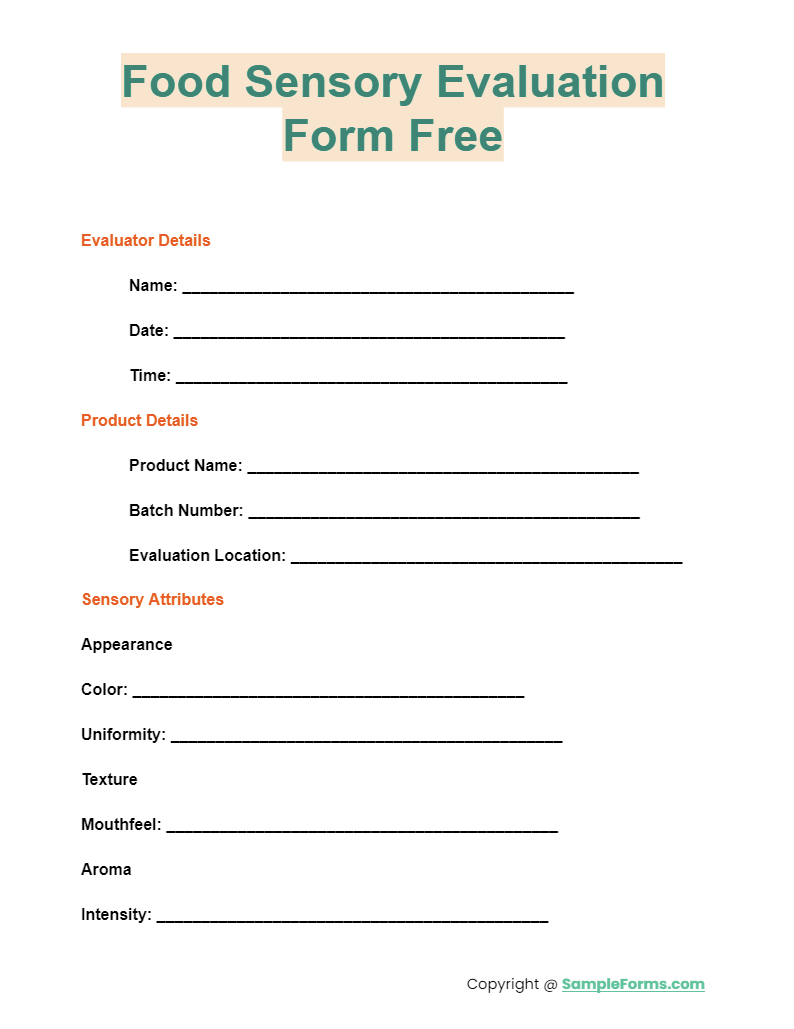
A Food Sensory Evaluation Form Free provides an accessible option for small businesses and startups to assess food quality. This form includes essential sensory attributes, similar to a Food Frequency Questionnaire Form.
Food Sensory Evaluation Form Online
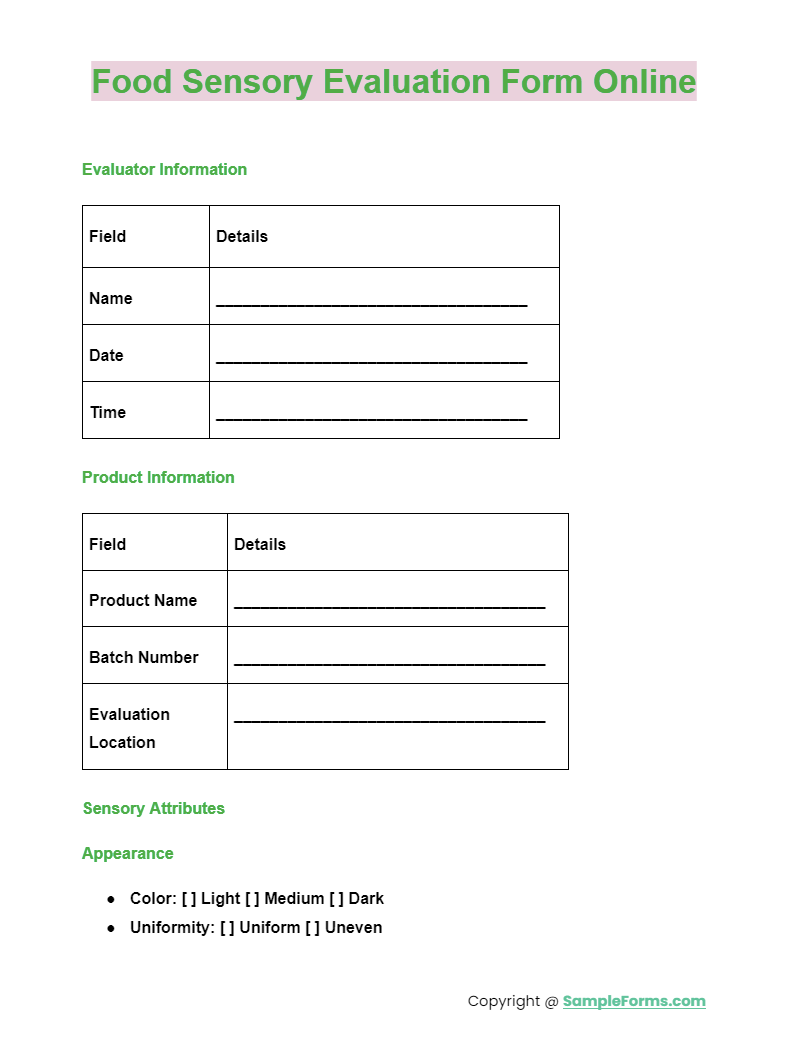
A Food Sensory Evaluation Form Online allows for digital and remote evaluation of food products. This form is easy to use and share, ensuring efficient data collection, much like a Food and Beverage Order Form.
More Food Sensory Evaluation Form Samples
1. Food Tasting Score Sheet
2. Food Evaluation Form
3. Taste Panel Evaluation
4. Catering Feedback Form
5. Sample Taste Test Evaluation Form
6. Food Service Employee Evaulation
7. Food Lab Sensory Evaluation Form
How do you write a sensory evaluation for food?
Writing a sensory evaluation for food involves detailed steps to ensure accurate and comprehensive feedback. Key steps include:
- Define the Purpose: Clearly state the objective of the sensory evaluation, similar to defining the purpose in an Employee Evaluation Form.
- Select Attributes: Choose specific sensory attributes to evaluate, such as taste, texture, and aroma.
- Create a Scale: Develop a rating scale (e.g., 1 to 5) for each attribute.
- Describe Methodology: Outline how the evaluation will be conducted.
- Gather Feedback: Collect and analyze the data from the evaluation.
What is the sensory evaluation of food activity?
The sensory evaluation of food activity involves using human senses to assess food quality and acceptability. Key steps include:
- Panel Selection: Choose a group of evaluators with diverse taste preferences, much like selecting participants for an Self Evaluation Form.
- Sample Preparation: Ensure samples are prepared and presented consistently.
- Evaluation Environment: Conduct evaluations in a controlled environment.
- Data Collection: Use standardized forms to gather sensory data.
- Analysis and Interpretation: Analyze the data to draw meaningful conclusions.
How do you describe food with sensory details?
Describing food with sensory details involves using descriptive language to convey the sensory attributes of food. Key steps include:
- Taste: Describe the flavors (sweet, sour, bitter, salty, umami).
- Texture: Detail the mouthfeel (crunchy, creamy, chewy).
- Aroma: Explain the smell (fragrant, pungent, mild).
- Appearance: Describe visual elements (color, shape, size).
- Overall Impression: Summarize the overall sensory experience, similar to providing feedback in a Training Evaluation Form.
What are the sensory criteria for food selection and evaluation?
Sensory criteria for food selection and evaluation ensure that food products meet quality standards. Key criteria include:
- Appearance: Evaluate color, shape, and visual appeal, akin to criteria used in an Employee Self Evaluation Form.
- Aroma: Assess the smell and its intensity.
- Taste: Judge the flavor balance and intensity.
- Texture: Examine the mouthfeel and consistency.
- Aftertaste: Consider the lingering taste after consumption. You also browse our Interview Evaluation Form
Types of Focus of Food Sensory Evaluation Forms
There are various types of food sensory evaluation forms in terms of what area of the food is focused. It may be the presentation or the taste. The evaluation form could even focus on both areas, presentation and innovation. Here are the types of focus of an evaluation form.
1. Presentation
Some food sensory evaluation forms focus on how the food is presented to the consumer. This type of food evaluation form focuses on how colors and some elements are effective to the contribution to the overall appeal of a dish. As what we have previously mentioned, presentation helps grab the person’s interest and appetite. You also browse our Internship Evaluation Form
2. Taste
Most food sensory evaluation forms focus on the food’s overall taste, how the food affects the experience of the diner. The food may be evaluated by the sweetness, spicyness, roughness, smoothness, etc. Sometimes one could even say that taste matters more at the end of the day. You also browse our Supplier Evaluation Form
3. Presentation and Taste
This type of evaluation form focuses on the two aspects—presentation and innovation. Out of the three, this type is the best kind since it assesses the two main areas that food evaluation forms must assess and not only one focus. This type of forms will help elevate a restaurant’s food preparation, taking into account the overall pleasure that both presentation and taste can offer to the customer. You also browse our Program Evaluation Form
Who Benefits the Food Sensory Evaluation Forms
1. Clients
The main people who benefit from the sensory food evaluation or survey forms are the ones who are the reason why food evaluation forms exist in the first place. Customers and diners benefit the forms because without them, no evaluation happens. If a restaurant level up their food selection, presentation, and taste, many customers will get satisfied and come back for more. You also browse our Event Evaluation Form
2. Critics
Critics’ reviews help diners assess what food is good to eat for dinner and what restaurant serves the best fettuccine. Critics use evaluation forms to either helps a restaurant gain more customers or destroy a restaurant’s status because they serve poorly prepared food. Critics are hailed as go to credible sources regarding the service feedback or food assessment. You also browse our
3. Food Business Owners
Food owners benefit from evaluation forms too. These types of survey forms help them assess how to improve their food selection and helps them see what went wrong. This type of file can also be seen as a status report by food business owners. You also browse our Group Evaluation Form
4. Chefs
Similar restaurant owners, chefs benefit the evaluation form to know where they went wrong with preparing the food and how can they improve the overall pleasure the food can give to a diner.
How to Create a Food Sensory Evaluation Form
Here are a few tips and steps on how to create a professionally adequate food sensory evaluation form.
Step 1: Select a Template
Go to template.net and select one of their professionally-designed evaluation form templates. Select one that fits your liking and download it. Customize it based on how you want to format your food evaluation form. You also browse our Leadership Evaluation Form
Step 2: Create a Table
Create a sturdy table for your evaluation form. This table must have enough spaces to accommodate the scores and ratings you will give. Do note that scores come with remarks.
Step 3: Place a Rating System
You must create a rating system like one is equal to a poor score, and five is similar to an excellent score. You can even do a rating system of 1 to 10. Correctly input the scoring system and elaborate it well. You also browse our Project Evaluation Form
Step 4: Leave a Space for the Food Names
For the first column, dedicate that space for the name of the restaurant menu’s food. Enumerate the food based on the food courses, such as an entree, dessert, main course, and side dishes. And in those food course groups, enumerate the food alphabetically.
Step 5: Assess the Form
You must assess your evaluation form after you have created it. You might have missed any grammatical or contextual errors while creating it. You also browse our School Evaluation Form
What are the 5 sensory properties of food?
The five sensory properties of food are essential for a comprehensive evaluation. These properties include:
- Appearance: Visual appeal and presentation, much like assessing presentation in a Peer Evaluation Form.
- Aroma: The smell and its impact on the overall experience.
- Taste: The primary flavors and their balance.
- Texture: The feel of the food in the mouth.
- Sound: The noise made when biting or chewing, which can affect perception.
How do you rate a food?
To rate food, assess its appearance, aroma, taste, texture, and overall impression using a structured Food Requisition Form. This ensures comprehensive and consistent feedback.
What is sensory experience of food?
The sensory experience of food involves how we perceive food through our senses: taste, smell, sight, touch, and sound. It’s similar to assessing in a Course Evaluation Form.
What is a sensory evaluation for nutrition?
A sensory evaluation for nutrition examines food’s sensory attributes to ensure it meets consumer preferences and nutritional standards. It’s akin to a Teacher Evaluation Form for educational performance.
What are the 4 sensory characteristics for Analysing food?
The four sensory characteristics for analyzing food are appearance, aroma, taste, and texture. These attributes are crucial for a thorough assessment, much like a Mentor Evaluation Form.
What is the triangle test in sensory evaluation of food?
The triangle test in sensory evaluation of food is a method to identify differences between two products. It’s as objective as a Mentee Evaluation Form in providing clear results.
What are the objectives of sensory evaluation of food?
The objectives of sensory evaluation of food are to improve product quality, ensure consistency, and meet consumer preferences. This process is similar to using a Driver Evaluation Form to enhance performance.
What is texture of food in sensory evaluation?
In sensory evaluation, food texture refers to the physical feel of the food, including attributes like crunchiness or creaminess, akin to feedback in a Workshop Evaluation Form.
What are good food descriptors?
Good food descriptors are words like sweet, sour, crispy, juicy, and aromatic. These help convey precise sensory attributes, much like terms used in a Sales Evaluation Form.
In conclusion, a Food Sensory Evaluation Form is a vital tool for ensuring the quality and consumer acceptability of food products. This article has provided a thorough overview, including samples, forms, and practical tips. Understanding how to use such forms, akin to an HR Evaluation Form, ensures comprehensive feedback collection and aids in product enhancement. Utilize our guidelines and examples to create detailed evaluation forms that help maintain high standards and drive continuous improvement in your food products.
Related Posts
-
FREE 5+ General Manager Evaluation Forms in PDF
-
Chef Evaluation Form
-
FREE 6+ Business Credit Checklist Forms in PDF
-
Employee Pay Increase Form
-
FREE 8+ Kitchen Evaluation Forms in PDF | MS Word
-
Customer Service Evaluation Form
-
FREE 15+ Grant Evaluation Forms in PDF | MS Word
-
FREE 14+ Volunteer Evaluation Forms in PDF
-
Mentee Evaluation Form
-
Speaker Evaluation Form
-
FREE 14+ Vehicle Evaluation Forms in PDF
-
FREE 14+ Trainee Evaluation Forms in MS Word | PDF
-
Resume Evaluation Form
-
FREE 14+ Retreat Evaluation Forms in PDF
-
Debate Evaluation Form
